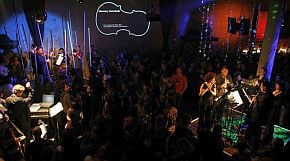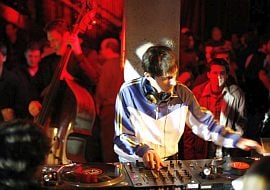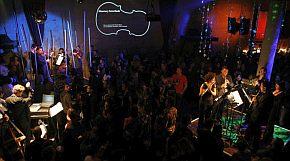
Still, I had a great time. Mercury Soul is more appealing to me than the average nightclub, as its music is definitely more interesting, and the volume not quite as deafening, the crowd not as stifling (no dry humping/freak dancing at this club), though the drinks are just as overpriced. Aluminum-art installations by Anne Patterson enhanced the atmosphere with what looked like electrified, metallic tumbleweeds or maybe hairballs suspended from the ceiling in frantic shapes frozen in midexplosion. The sculptures exuded an air of modernity and restless energy.
In the dimly lit hall, patrons were free to mill about, converse with friends, drink, dance, or simply stand and listen. The performers were illuminated by spotlights and elevated on raised islands above the sea of people. But try as these musicians might, they had no chance against the relentless beat-box. The musicians were at the mercy of the mixing board operator, who for most of the evening favored the night-long UDD-TSS, UDD-TSS, UDD-TSS ostinato at some 90 to 100 decibels.
Top-notch musicians with great instruments and decades of training and expertise played with their full potential left unused — or, if it was used, as done in John Adams’ Book of Dances, the playing might have been great yet it couldn’t really be appreciated. Even standing close enough to the ensemble to look over their shoulder and peek at their sheet music, I could not hear them clearly; could not follow the carefully written lines, the weaving dialogues, the rhythmic counterpoint; could not hear all the things that make “classical music” great — everything was being muddled into a noisy pulp by UDD-TSS, UDD-TSS.
For the most part, these fine musicians were relegated to accompanying the thudding electronic beat-box (rather than the other way around) by repeating simplistic, eight-bar loops of easy rhythms and detached phrases.
Or maybe there was more to it than that; if there was, I couldn’t hear it above the din. Or perhaps I’m just too accustomed to the established concert-hall setting.
Classical music’s much-reviled stuffy format, with the silent sitting and the ritualized clapping procedures, has been blamed for scaring away a generation of concertgoers. Call me old-fashioned, but Mercury Soul’s contrasting format truly highlighted how essential concert silence actually is. What use is all the musical expertise, capability, careful honing of phrases, and the like, if none of it can be heard properly?
Concept Is King

Mason Bates, aka DJ Masonic’s Mercury Interludes, provided the soundscape for most of the evening, weaving seamlessly into works by two John Adamses (John Coolidge Adams, the well-known composer of El Niño and Doctor Atomic, and the lesser-known John Luther Adams), Luciano Berio, and Steve Reich — maybe too seamlessly, as it was easy to miss the transition between some pieces on the program. The concert/party started (late), at around 9:30 p.m., officially ended at around midnight, and reportedly went on into the wee hours. The diverse crowd, which ranged from older men in slacks to party girls in minis to hipsters high on something, was sizable but nowhere near the 1,400 advertised from last year.
Fusing genres has always been one way to create interesting new music based on existing traditions and practices. It can lead to fascinating results, though straddling borders is risky. Combining two genres that have completely different approaches can result in square pegs in round holes. Bates’ electronica are creations of the all-night drugged-up dance club scene. Playing music intended for the concert hall simultaneously doesn’t make sense because it only gets obliterated.
This isn’t to say that a different sort of fusion isn’t possible. Bates’ Digital Loom CD, for example, features artfully mixed and beautifully nuanced electroacoustic compositions that borrow from beats inspired by hip-hop as well as from classical complexity. I don’t know whether he would appreciate having someone superimpose UDD-TSS, UDD-TSS on top of his carefully composed CD.

